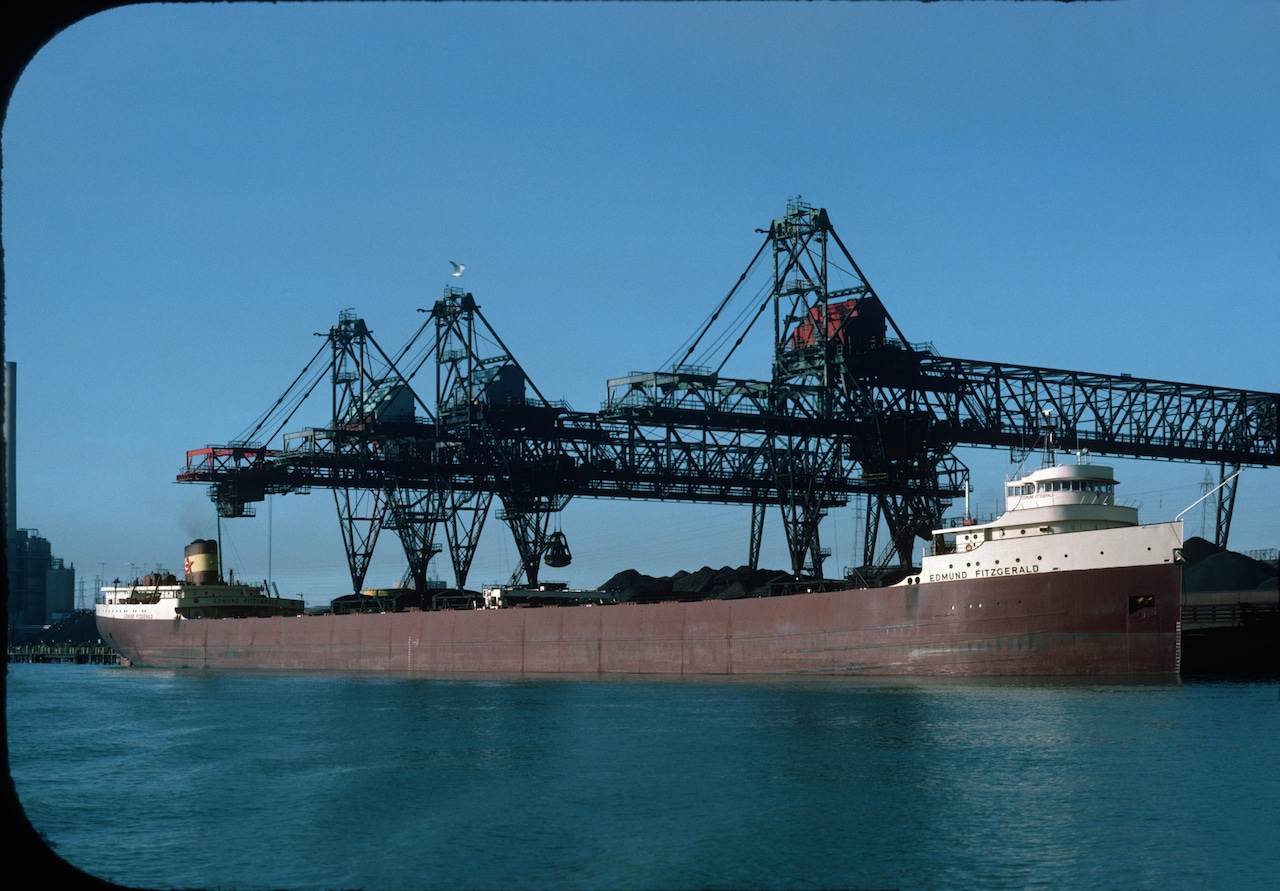Copyright cleveland.com

CLEVELAND, Ohio – Few ships in Great Lakes history are as legendary as the Edmund Fitzgerald, especially across Northern Ohio, which was home to nearly half the 29 seamen who went down with the lake freighter in a fierce storm on Nov. 10, 1975. There’s the USS Niagara, featured in the Battle of Lake Erie during the War of 1812, but it was a warship, built to dispatch the enemy. The “Mighty Fitz” was a vessel of commerce. A 729-foot ore boat that hauled taconite pellets from the Iron Range up north to the steel mills of the lower Great Lakes. It was the biggest and fastest freighter on the lake when it was christened in 1958, and yet 17 years later it would be no match for the waves and the wind that pummeled its long, narrow hull into submission. It rests to this day at the bottom of Lake Superior - the last major vessel to be lost on the Great Lakes after decades of wrecks - and the legend, 50 years later, is as gripping as ever. Pop culture icon Immortalized in song, endlessly scrutinized by historians, and remembered solemnly each year by family and friends of those who perished, the Edmund Fitzgerald, for all the inherent sadness that surrounds it, is a cultural icon. Fascination with the ship and the events that tore it asunder show no signs of letting up. An outdoor public ceremony is planned at the Great Lakes Shipwreck Museum at Whitefish Point, Michigan, on the afternoon of Nov. 10, followed that evening by the annual private gathering for families of the victims. It will be livestreamed. In Toledo, the National Museum of the Great Lakes has several events scheduled, including a tribute concert at the Valentine Theater by Meredith Moon, daughter of Canadian songwriter Gordon Lightfoot, whose mournful ballad “The Wreck of the Edmund Fitzgerald” was a billboard hit in 1976. Two stanzas in particular captured the mystery and emotion that still linger in America’s collective consciousness, long after the bell at the Mariners’ Church in Detroit first rang - 29 times - for each man on the Edmund Fitzgerald. They might have split up or they might have capsized They may have broke deep and took water And all that remains is the faces and the names Of the wives and the sons and the daughters The human toll Why the Fitz sank is still debated, with the U.S. Coast Guard, the National Transportation Safety Board and the Lake Carriers’ Association at the time drawing various conclusions. Some blame leaking hatches that allowed water crashing over the deck to flood the fully loaded boat, although a subsequent review concluded the crew in charge of securing the hatches would not have been at fault. Others believe the ship’s bottom scraped the shoals along the Canadian coast while taking what was thought to be a safer route in the storm. Capt. Bernie Cooper of the lake freighter Arthur M. Anderson, which was trailing the Edmund Fitzgerald by 10 miles when it went down, thought the ship “bottomed out” and had been taking on water for hours before the huge sea devoured it whole. The Fitzgerald’s captain, Ernest McSorley, had radioed earlier in the day that his ship was listing to one side and had suffered structural damage, and yet at 7:10 p.m. he responded to the Anderson, “We are holding our own.” Minutes later the ship vanished from the Anderson’s radar. “I believe he hung up the phone from that last call and dove right under,” Cooper told a U.S. Coast Guard Board of Inquiry several days later, according to an account in The Plain Dealer. “I don’t think those fellows even had time to get out of the wheelhouse.” Whatever led to the Fitzgerald’s demise, the time for ruminating has passed, and the focus should be on the unfortunate souls and those they left behind, said Chris Gillcrist, director emeritus of the National Museum of the Great Lakes. “All of these people had lives,” he said, “and we shouldn’t define them by their last 10 minutes.” From Bay Village to Ashtabula Of the 29 men on board, seven were from Northeast Ohio – Bay Village to Ashtabula - and just as many from the Toledo area, including McSorley, 63, who had an ill wife and was expected to retire after the ship docked for the season. His first mate was John “Jack” McCarthy, who at 62 was also planning to pack it in. His son, John McCarthy, was 30 at the time. A graduate of St. Ignatius High School in Cleveland, he had spent college summers on ore boats, including a stint as a wiper in the engine room of the Fitzgerald. McCarthy was an insurance adjuster and marine surveyor in the Virgin Islands when word went out that his father’s ship was lost. He remembers waking up and vaguely hearing something about the Edmund Fitzgerald on the radio. He got the full report from his manager and then called his mother, who had yet to hear the news. He suggested she call a family friend at Oglebay Norton, the shipping company based in the Hanna Building in Downtown Cleveland that operated the Edmund Fitzgerald. “And I called her back in a little while and she was all in disarray,” he said. It took McCarthy two days to get a flight off the island, and when he did, a friend from St. Croix sat beside him on the first leg to Miami. By the time McCarthy reached his parents’ home in Bay Village, the worst had been confirmed. “I think they all had been declared lost,” he said. Eddie Bindon Jim Majoros was working at his grandfather’s nursery southeast of Fairport Harbor when he first learned of the tragedy. His father’s sister was married to Eddie Bindon, a first assistant engineer on the Fitz. “I think his wife, Helen, called my mom to let us know the ship went down and at that time there was no more information because they were out searching,” Majoros said. He and his father, who together had been cutting down Christmas trees, just looked at each other. “I felt like somebody hit me, punched me in the gut,” Majoros said. Uncle Eddie was a fun-loving guy, Majoros recalled, and there were times during family get-togethers that Bindon and his father, an iron worker and former ship welder, would talk about the lake freighters, including the Fitz. Bindon described being below deck on the Fitzgerald during a storm and losing site of the door at the far end of the companionway because the boat was twisting so much, which it was designed to do. “It would return back to normal,” Majoros said, “but it was one of those things it would twist and come back.” On Sunday, the Fairport Harbor Historical Society is holding a ceremony at the local VFW post to remember Bindon, 47 when he died, and the other 28 lost seamen. “My wife and I are planning on going for sure,” Majoros said. Bill Simko, 91, a Fairport Harbor resident who spent time on the Fitz in 1958 and 1959, will speak at the event. He will talk about life on the lakes and share a few stories about his friend Bindon, including how he got stuck in a boiler while working on a freighter in Fairport Harbor during the off season. “And he came out with some beautiful language,” Simko said. He’s also likely to mention how Bindon bought his wife a 2-carat diamond ring for their 25th anniversary, although she didn’t find out about it until after he was gone. He had left the ring with a friend before getting on the Fitz for the last time. “For some reason, he didn’t want to take it aboard the ship,” Bindon’s niece Fran Gabor told the Detroit News in 2014. “He just had an ominous feeling – at least that’s how it seems.” Deckhands and friends Other crewmen hailing from Northeast Ohio included Bruce Hudson, 22, of North Olmsted and Mark Thomas, 21, of Richmond Heights. They were deckhands who became good friends and planned to drive across country in Hudson’s burgundy Dodge Challenger after the shipping season ended. Hudson was the only child of Oddis and Ruth Hudson. Both worked on assembly lines, he for General Motors and she at Bonne Bell cosmetics. She found out her son’s ship had gone down, not from Oglebay Norton, but from the radio as she was driving to work. “She doesn’t even remember how she got home,” said her niece, Pam Woodman Wittig. For a brief period, the Hudsons held out hope that their son was the seaman rumored to have missed the ship because of sickness. No such luck. Their only child and Wittig’s cool older cousin, who made her girlfriends swoon, was gone. “He was one of those kids who could fit in everywhere,” said Wittig, who was 14 at the time. He played the trombone in high school and was an Eagle Scout. “He was friends with the jocks. He was friends with everybody.” Hudson was also was going to be a father, his girlfriend having told him over the phone that she was pregnant. “And they had plans for when the ship docked that they would get an apartment together and raise a family,” Wittig said, but she was cool with Hudson and Thomas making their cross-country roadtrip first. Thomas, whose father, Robert Thomas, was general counsel for Oglebay Norton, had been weighing whether he wanted to stay in the marine business, according to Thomas Green, who would become Oglebay Norton’s CEO in 1992. Green explained in a documentary about the Fitzgerald called “A Good Ship and Crew Well Seasoned” that it fell on the elder Thomas to settle the accounts of the lost seamen, including his own son. “He never was the same individual,” Green said. “It was just so tough.” The disaster also devastated the freighter’s namesake, Edmund Fitzgerald, chairman of the Northwestern Mutual Life Insurance Co., which was the Milwaukee firm that financed construction of the ship and leased it to Oglebay Norton. Fitzgerald didn’t want the boat to bear his name, but he was overruled by his own board. His grandson Alexander “Sandy” Cutler, who would become chairman and CEO of Eaton Corp. in Cleveland, told the Plain Dealer in 2006 that the sinking was a tragedy his grandfather took personally. Two from Ashtabula The sinking also hit hard in Ashtabula, hometown of deckhand Paul Riippa, 22, and watchman Karl Peckol, 20. Peckol, the youngest of the crew, had signed on to the Fitzgerald to earn money for college, said Diana Martinez Perry, who played clarinet beside Peckol in high school. Her father, Hector Martinez, was the band director. Peckol was going to meet with him when he got off the ship to discuss music schools, she said. Not only was Peckol whip-smart and funny, but he was humble, Perry said. “He was the best clarinet player by my senior year, and he didn’t act any different.” Jim Paulchel, who taught Peckol in 8th grade and sailed one season as an officer’s porter on the lake freighter Charles M. White, said Peckol was always smiling. The two of them last crossed paths in the vestibule of the old Carlisle’s department store in Ashtabula. “We just exchanged niceties between us and he told me what he was doing,” Paulchel said. As best he can recall, it was a couple months before Peckol’s life would be cut short. “Yepper, he was a good kid,” Paulchel said. Also from Northeast Ohio was James A. Pratt of Lakewood. A story from the Plain Dealer said he was 44 when he died and left behind a wife and 5-year-old daughter. Tight bonds No shortage of books, documentaries and museum exhibits has kept the legend of the Edmund Fitzgerald alive over the years. Great Lakes Brewing Co. in Cleveland even named a beer after it. The label shows a drawing of the boat being tossed around in high seas. “The Gales of November: The Untold Story of the Edmund Fitzgreald,” by John U. Bacon, was recently published to great acclaim. It traces not only the events surrounding Nov. 10, 1975, but details the lives of several crewmen and the role the Edmund Fitzgerald played in the economy of the day. And, of course, there’s the song. Those in the know point out that Lightfoot got it wrong in a few places. The ore the Fitz was hauling came from a mill in Minnesota, not Wisconsin, although that’s where the ship had loaded up. And it wasn’t headed to Cleveland, but to Zug Island on the Detroit River. Decades later, Lightfoot would replace the lyric “a main hatchway gave in” during his performances, after research had absolved the crew of being responsible. That meant a lot to Ruth Hudson, whose son was a deckhand, and she grew close to Lightfoot over the years. A driving force to protect the dignity of her son and his shipmates, whose bodies were left with the crumpled Fitz, Hudson pushed to have the wreck site, which is in Canadian waters, declared off limits. Back in the day, when long distance calls were expensive, she reached out “to everybody in Canada,” Wittig said, and was even invited to speak before Parliament. She and other family members of the victims watched as a Coast Guard cutter retrieved the Fitzgerald’s bell that is now on exhibit at the Great Lakes Shipwreck Museum. For years, Hudson made the annual trip to Whitefish Point for the bell-ringing ceremony on Nov. 10. She missed it in 2014 because of failing health and the following year, on the eve of the 40th anniversary, she got a call at her assisted-living residence in South Carolina from Lightfoot. They talked for several minutes “like they were old friends,” Wittig said. “... and just a couple hours later she passed away.” Wittig has made friends with family members of the victims, including the daughters of Oliver “Buck” Champeau, a third assistant engineer from Sturgeon Bay, Wisconsin, who was 41, and Blaine Wilhelm, an oiler from Moquah, Wisconsin, who was 53, when their floating workplace met its end. She was to reunite them this weekend at Whitefish Point, about 17 miles from where the Edmund Fitzgerald lies broken in two. One who won’t be there is McCarthy, who will do what he usually does on the anniversary: toast his father and the 28 others at the West End Tavern in Rocky River. The tradition began nearly 40 years ago with him, then-pub owner Parnell Egan and a couple of shots. It has since grown to include other members of the Great Lakes community, but never has it been used to attract business to the bar. It’s a solemn affair that occurs shortly after 7 p.m. and usually involves a bagpiper playing Amazing Grace and an Irish dirge. Someone always reads the name, age, position and hometown of each of the crewmen who died. “It’s not packed to the gills, but it’s pretty full,” McCarthy said. “It’s a short ceremony and it’s for all twenty-nine.” What bothers McCarthy most, he said, is that a good guy like his father, a caring man and a great provider to his family, lost his life in such a cold, dark and violent way. McCarthy can still remember his father calling home when report cards came out to see how he, his brother and two sisters were doing in school. “It was like going to confession,” McCarthy said fondly, with all four lining up for their turn on the phone. “It was just a credit to him,” McCarthy said. “He was very involved, even though he was far away.”



